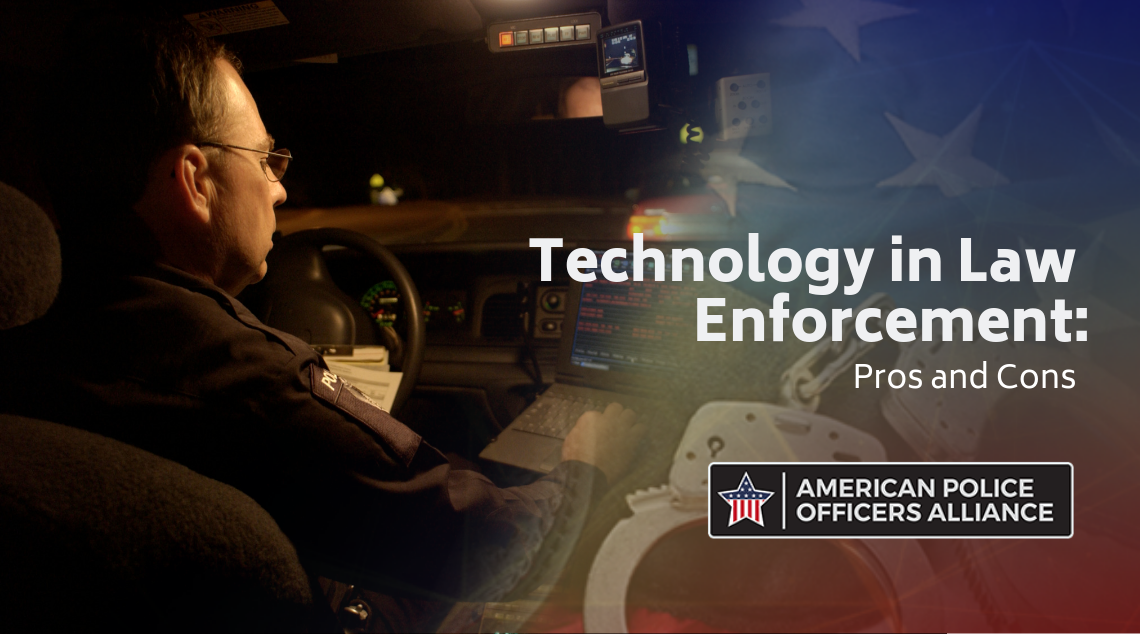As technology continues to evolve, law enforcement agencies are having to keep up. Agencies at all levels are investing in the latest and greatest technologies in order to better serve and protect their officers and communities.
Combating criminal activity with technology has its pros and cons on both sides. Both the police and the community need to be aware of these new technologies that are being used and their rights. Below, we outline some of the most common benefits and downfalls when it comes to technology in law enforcement.
The Pros of Technology in Law Enforcement
Added Protection for Police and Community
Body cameras have been an excellent addition to many law enforcement agencies across the United States. While there are negative aspects of this technology that police officers need to be aware of, body cameras have proven useful in many instances across the country.
The use of lethal force by police has been an extensive conversation over the past decade. With the never-ending news cycle and virality of social media, these situations can quickly get out of hand before any facts have been brought to light. Body cameras are a technology that has helped the public get a front-row seat to what police see and how they respond.
For example, in Cleveland, Ohio, four police officers faced trial regarding an instance where lethal force was used. Thanks to body camera footage, the public could hear and see the actions of those officers and decide if their actions were justified.
Another great technological advancement that law enforcement agencies are using every day is GPS systems. GPS systems allow for officer monitoring and tracking, which can be especially helpful if a police officer is in a situation where he or she can’t be reached or is unable to call for help.
In 2014, a criminal was caught by Philadelphia police officers using GPS tracking. While the GPS tracker wasn’t initially placed in the car to help police track criminals, the criminal was able to be followed by the GPS system in his car when he purchased it.
Assistance with Identifying and Finding Criminals
Facial recognition algorithms are giving law enforcement agencies a new tool to identify suspects in criminal cases. These algorithms can be used in two different ways. Any photos, videos or sketches of the suspect can be compared to a database of known criminals. The DMV’s database can also be used in this way.
In 2017, a criminal in Las Vegas was caught using facial recognition at the local DMV. This type of technology allows criminals who have been on the run for over 25 years to be caught, and justice to be served.
All in all, technology within law enforcement has created a lot of benefits that are helping different departments solve crimes, identify suspects, and track them down. However, the downsides of technology within law enforcement are just as important to be aware of.
The Cons of Technology in Law Enforcement
Like most things, there can be downsides to technology being integrated into just about every aspect of law enforcement.
More Distractions for Officers
Most people have been able to see within a police officer’s car, whether sitting next to them at a stoplight or maybe even from the backseat of one. Within almost every police officer’s car is a laptop that has its own built-in dispatch system. While this may be helpful in certain situations when a call does come through the computer, the police officer may be driving, which could be distracting – the result could be an accident.
Drivers are advised not to use technology while driving; some states have even created laws to enforce it. These laws are created and enforced to ensure everyone remains safe on the roads. So why are police officers risking their safety?
Privacy Concerns for Police and Citizens
Exposure is another downside that may not be considered when implementing technology into the workplace. Body cameras do offer an array of benefits such as accountability and honesty, however, they can be seen as a threat.
One concern that hasn’t gotten the attention it deserves is the privacy invasion of body cameras. In some states, laws have been pushed to have cameras rolling 24/7, which can be a privacy concern for officers. Officers still talk to their partners and significant others, take lunch breaks, and go to the bathroom like the rest. Having a camera rolling 24/7 that could potentially document personal actions and conversations can put an undue burden on the officers.
Another consideration is how the public reacts to being recorded when interacting with the police. When body cameras are rolling, suspects, victims, and witnesses may get hostile about being recorded. Public exposure for victims can be embarrassing and painful, especially if their experience was traumatic. For example, should the cameras be rolling while discussing a situation with a potential domestic violence victim?
Is Police Technology Moving Us in The Right Direction?
As technology continues to make significant developments, it is up to every state to ensure that their police officers are safe, honest, and efficient in the line of work that they do. Law enforcement agencies are on the right track by working with the Department of Justice to implement policies and programs that keep their officers safe and accountable.
Aside from safety and accountability, more agencies need to work toward implementing control regarding body cameras. Technology doesn’t need to capture a phone call to the kids or even an officer using the restroom. As technology continues to evolve and make progressive changes, we’re confident that implementing access and controls into body cameras can be done effectively to increase the pros and decrease the cons of technology in law enforcement.
Interested to learn more about technology in law enforcement? Read other articles from our Police Tech series.








